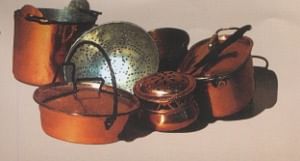Where roots create proximity
Display of traditional folk-arts from Switzerland and Bangladesh
Cultural Correspondent
As one roams around the auditorium gallery of the National Museum, one comes across a veritable cultural feast-- an ongoing exhibition of arts and crafts from the tiny mountainous country of Switzerland. The exhibition, the first of its kind in Dhaka, was organised by the Embassy of Switzerland and Bangladesh National Museum. On display also was a wide range of traditional Bangladeshi items.In his welcome speech, the Charge d'Affaires of Switzerland in Bangladesh, Juerg Casserini said, 'The exhibition reveals a strong cultural affinity between the two countries.' Visitors at the exhibition focussed their attention on the widely diverse Alpine heritage, mainly of rural origin, with a subtle touch of Latin influence and European style. A rare treat for the locals was the display of intricate hand-made arty objects and masterpieces brought in from Swiss Cantons including Appenzell, Grisons, the Tessin, Berne, Fribourg, Valais, Zurich and Schaffhausen. A prime emblematic motif of Swiss heritage no doubt, finds itself in the figurative element of the burly cattle herd, a key symbol of wealth and prosperity. Gigantic models of lightly gilded brass cow-bells with embroidered leather collars is a key attraction. These objets d'art stand boldly beside a wood encased Dulcimer, a popular rural musical instrument of medieval Arab origin. The metallic cow bells of Bangladeshi tribes come as a pleasant surprise in the exhibition and augment the bells of the Alps. Dolls, adorned in splendidly woven vibrant costumes, maintain a discrete appearance and represent the customs of different Cantons. The display of Bangladeshi dolls in bridal costumes and rural outfits complement those of their Swiss counterparts. Likewise, the embroidered apparel is testimony to the superb craftsmanship of rural women of both the countries. Carved wooden spoons, gracefully designed jewellery boxes, cheese moulds, cigarette boxes, miniature hay-wagons, cows and sledges serve to draw attention to the delicate artistic traits of rural sculptors of Switzerland. Needless to say, the wooden dolls and cake moulds by Bangladeshi carvers enrich the exhibition. Certain antique items including the ornamental hookah (a rural smoking device), produced from silver, illustrates our rich cultural heritage. The products seem to be equivalent to the customary brass and copper works of the Alpine craftsmen. Hand-painted ceramic pieces and porcelain-ware with gold and silver brooches, chrome-plated steel and fire-kilned copper from various Swiss Cantons seem remarkably parallel in nature with our Pathor Hari, the Bangladeshi stone utensil. The role of the mask in Swiss culture is important, especially during seasonal festivities and carnivals. Wooden masks, with motifs of wild man and woman on the far corner of the gallery, are surely crowd-pullers. In comparison, displays of flamboyant masks created by Bangladeshi artistes are equally appealing. The exhibition is open from 10 am to 5 pm daily till August 10.
|

Copper kitchen utensils decorated with a planished design |